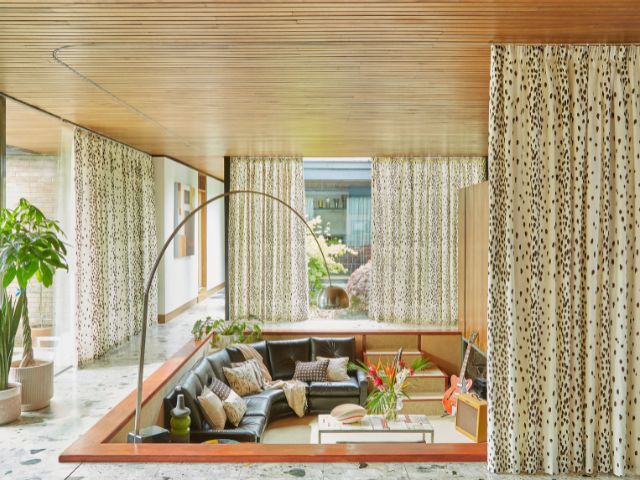
Image Credit: Hillary's
From runway to room: 7 chic interior design trends inspired by the catwalk
After a whirlwind start to the year the Autumn/Winter 2025 catwalks of Milan, Paris, New York and London have finally wrapped after six weeks of glamour, sparkle and cutting edge couture.
While the focus is, of course, on the clothes and accessories, the impact of fashion weeks extends far past the runway.
In fact, the often outlandish looks can also influence the interior design and décor of our homes.
As fashion designers revealed their coveted collections, the trends, colours and materials featured on the models will inspire interior designers for the upcoming year.
“Fashion and interior design are two sides of the same coin, both tell a story, both reflect our personal taste, and both evolve with the times,” explains Kunal Trehan, interior designer and founder of Touched Interiors.
“What we see on the runway often finds its way into our homes, reinterpreted in fabrics, textures, and colour palettes.”
Kunal says interior designers, much like fashion designers, often take inspiration from the past and reimagine it in a way that feels fresh, modern, and luxurious.
“Trends in fashion are a preview of what’s to come in interiors and what we wear is often a reflection of what we want around us in our home too,” he continues.
“Just as a couture gown is made with exquisite attention to detail, the perfect well-designed interior should feel just as curated and intentional.”
From modern florals to fancy fringing and calming colour palettes, we spoke to the interior experts to uncover some of the fashion week looks to adopt in your wardrobe and also your home.
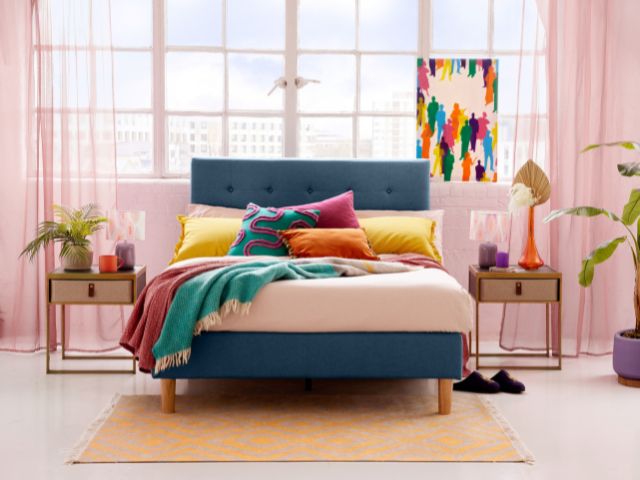
Trash-chic
Although trash-chic fashion was taken quite literally at London Fashion Week, you don’t need to cover your sofas in bin bags to bring this trend into your home.
“Trash-chic is, at its core, about being environmentally friendly and sustainable,” explains interior design expert Ryan McDonough at MyJobQuote.co.uk.
“It’s often represented on the catwalk with a mix of vintage, retro and unusual clothing pieces that create an expressive style and this ethos transfers well into interior design.”
To achieve this look in your home, Ryan suggests combining vintage and second-hand furniture with antique and handmade decorative pieces made from sustainable materials.
“This could be a hand-me-down dining table and mismatched chairs sourced from online marketplaces and car boot sales,” he explains.
“The table itself could be decorated with handmade pottery and charity shop finds.
“For a tablecloth, you might sew together fabric remnants to create an eclectic and characterful dining space.”
Victoria Robinson, style and trend expert at Hillarys agrees that trash-chic fashion, with its emphasis on recycled and repurposed materials, can inspire a creative approach to home decor.
“Think upcycled furniture and DIY projects that give new life to old items,” she suggests.
“Mix and match different styles and eras for a curated yet casual look. And add quirky art pieces or vintage finds to personalise your space.”
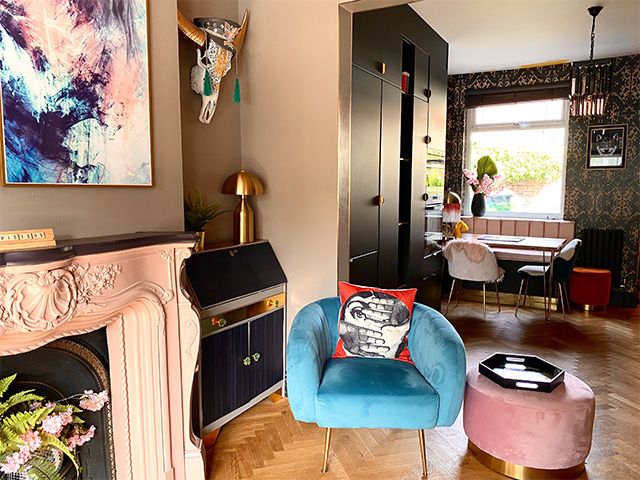
90s
The resurgence of 90s fashion has brought the return of animal print, bright colours, and bold patterns; all trends seen on the runways of London Fashion week and all perfect looks to use for inspiration for your home’s interior design.
“With the 90s trend we’re shifting away from minimalistic features, and moving towards upping the feel-good-factor with fun, fluid shapes, and head-turning colours,” explains Marlena Kaminska, lead digital designer at ValueLights.
“One trend that’s everywhere at the moment and complements a return to 90s style is colour drenching – taking one colour and using that as a theme throughout the room, with everything, from walls and soft furnishings, to lamps and even radiators being ‘drenched’ in hues of that colour,” she adds.
Interior designers say they are also seeing a renewed love of animal print, which was a key 90s trend and has been seen on fashion week catwalks around the world.
To incorporate the leopard look in your home luxury interior designer Tommy Kebbson of Kebbson & Co. suggests opting for a light touch.
“This can be done in a more minimalist way to match 2025 by introducing animal print into smaller additions such as pillows or small sculptures or wall art throughout the home,” he explains.
“I would also recommend blending this in with your colour palette rather than invading the space with intense patterns that don’t match.”
Dopamine décor also reflects a resurgence of 90s inspired bright and bold colours.
“We’re seeing a lot more colourful fixtures, playful designs, and warm tones coming through,” explains Marlena.
“Printed lamp shades and colourful glassware are perfect for adding a pop of colour and positive energy into your space.”
For further 90s home inspo Kunal recommends opting for curved furniture, modular sofas, and sculptural coffee tables that feel effortlessly cool.
“Keep the base colour scheme neutral (beiges and muted whites) and add a bold accent like a cobalt blue chair or a deep red wine ottoman,” he adds.
“And incorporate mirrored surfaces, acrylic furniture, and chrome lighting for that refined, minimalist 90s edge.
“My top tip is opt for mirrors with a bronze finish so the finished look is still warm.”
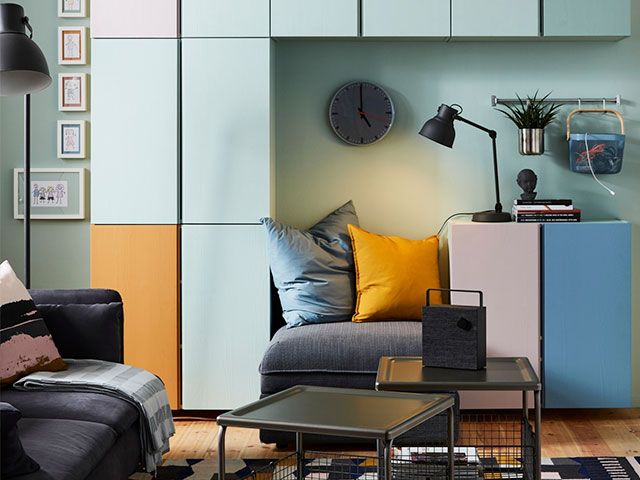
Embellishment
Fashion is embracing embellishment again, beaded gowns, pearl accents, and crystal embroidery are everywhere.
“No longer just about decoration, embellishments in fashion are now a statement of impact, boldness, and rebellion,” explains interior designer and founder of Ayisha Onuorah Design Studio.
“On the catwalk Dsquared’s approach to embellishments wasn’t delicate or dainty – it was powerful, high-shine, and unapologetic, featuring heavy metallics, studs, and oversized crystal details.
In interiors, this translates to gloss finishes, statement lighting, and luxe metallic surfaces that demand attention.”
To incorporate embellishment in your own home Kunal suggests opting for furniture with embroidered or beaded fabric, especially in cushions or stools, for a couture-inspired look.
“Add metallic or jewel-encrusted hardware to doors, cabinets and drawers,” he adds.
“Keep It tasteful, though.”
Kunal also suggests investing in artisanal rugs, wallpaper with intricate patterns, or furniture with inlaid detailing to bring that luxury fashion feel into your space.
For Ayisha, adopting some metallic elements into your scheme is another simple way to embrace embellishment at home.
“More than just decorative, metallic accents bring impact, structure, and edge,” she explains.
“Whether sculptural or functional, steel, brass, and chrome can transform interiors into something sleek, stylish, and unapologetically glamorous.”
She also suggests using lighting as a form of “jewellery” for your space.
“Much like accessories complete an outfit, statement lighting defines a room,” she explains.
“Think Soho Home-inspired floor lamps with chrome or smoked glass accents, channelling Dsquared’s bold metallic embellishments.
“Sculptural glass chandeliers, reminiscent of oversized beading, can also become the statement jewellery of the space.”
And if you’re looking for a dramatic way to adopt home-based embellishment, it could be time to rediscover a love for the glass brick.
“Glass bricks are back, but not in the way you remember,” Ayisha explains.
“Today, they’re being used to create textured, light-catching walls that feel modern and architectural, adding drama and a dynamic play of light to interiors.”

Modern florals
No longer just soft and romantic, florals on the AW25 runway took on a bold, textural, and statement-making presence.
“Whether abstracted, graphic, or sculptural, these florals were anything but dainty,” explains Ayisha.
“In interiors, florals are taking on a new energy, moving beyond traditional prints into high-impact wallpapers, intricate mouldings, and textural installations that redefine botanical motif in a contemporary space.”
One simple way to incorporate modern florals into your space is to opt for a bold floral wallpaper.
“Maximalist, colourful, and dramatic – just like Richard Quinn’s graphic floral prints, these wallpapers transform a room into a statement piece,” Ayisha explains.
“For a more understated yet sophisticated approach, opt for embossed textures, muted palettes, or woven grasscloth finishes.
“This aligns with Erdem’s delicate, painterly aesthetic, offering a refined and elegant touch.”
And don’t forget about flower power on the fifth wall.
“Ceilings matter,” says Ayisha.
“A hand-painted botanical fresco or a wallpapered ceiling adds an unexpected, artistic element, creating a truly unique and immersive space.”
For a really bold look with blooms, Ayisha also suggests pushing the boundaries by incorporating floral or botanical motifs into skirting, architraves, or ceiling medallions for a nod to historic grandeur with a fresh, modern attitude.
“Just as florals on the runway gained new structure, interiors can bring them to life architecturally—not just through textiles. Roses aren’t just for ceilings!” she adds.
More simply she suggests incorporating the modern floral fashion trend via a gallery wall of botanical art.
“Curate a mix of large-scale floral prints, vintage botanical sketches, and abstract compositions, mirroring the way designers layered floral textures and silhouettes on the runway,” she says.
“For a subversive twist, consider embroidered or tapestry-style florals—blurring the line between art and textile.”
For Tommy, the modern botanical trend aligns perfectly with the noise surrounding biophilic design.
He suggests nodding to the look by bringing the outside into your home through plants and earthy colours.
“It prioritises and incorporates natural elements into your home, which is thought to promote a healthier living environment through using plants, natural materials, natural landscapes, shapes and patterns, as well as natural light,” he adds.
And don’t forget about floral furnishings and window dressings.
For blinds and curtains Victoria suggests opting for oversized or abstract floral designs to keep the look contemporary.
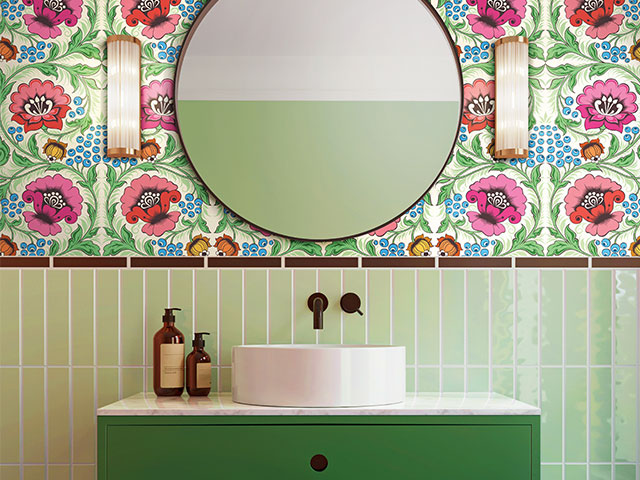
Tartan 2.0
Whether it’s a nod to our obsession with the Traitors or a return to classic styling, tartan made a prominent appearance at LFW AW2025, most notably on Burberry and Kent and Curwen.
“Plaid and tartan have a rich history and an undeniable versatility, making them a timeless addition to any space,” explains Ayisha.
“Incorporating these patterns can instantly add warmth, character, and a sense of heritage while maintaining a modern feel.”
She cites Paloma Elsesser’s Brooklyn townhouse, featured in Architectural Digest as a perfect example of this thoughtful integration.
“Her space beautifully weaves plaid into the decor through art and accent pieces, most notably her Bernard Brunier chairs, thoughtfully upholstered in Pierre Frey wool plaid,” she explains.
“The result is a seamless blend of vintage charm and contemporary elegance.
“Pairing neutral elements with tartan accents is a great way to pay homage to classic patterns whilst maintaining a curated and modern feel.”
For a more subtle touch, Ayisha recommends introducing plaid through soft furnishings – cushions, throws, or an upholstered bench – small details that bring a space to life without overwhelming it.
“If you’re feeling bold, tartan-patterned wall coverings can add personality to smaller spaces like a home office or small WC,” she adds.
Patterned tiles are another striking option. “Designs like Petra Palumbo’s tartan tiles are a bold and interesting way to introduce this pattern to your home,” Ayisha adds.
“And tiles aren’t just for bathrooms – they can be used on window reveals, skirting, or as a decorative architrave for a bespoke design feel to your space.”
Checkerboard, a pattern with a similarly structured visual rhythm, has also made a strong resurgence in interiors.
“From ceramics to wall coverings to tiles, this timeless pattern serves to bring character and warmth, offering a slightly more structured and graphic take on plaid,” she concludes.
If you want a modern way to introduce tartan, Tommy suggests switching up the colour palette.
“Tartan doesn’t have to be the bright red and green that is traditionally thought of, instead you can add some monochrome tartan for example,” he suggests.
“This can work well within a kitchen space, especially.”
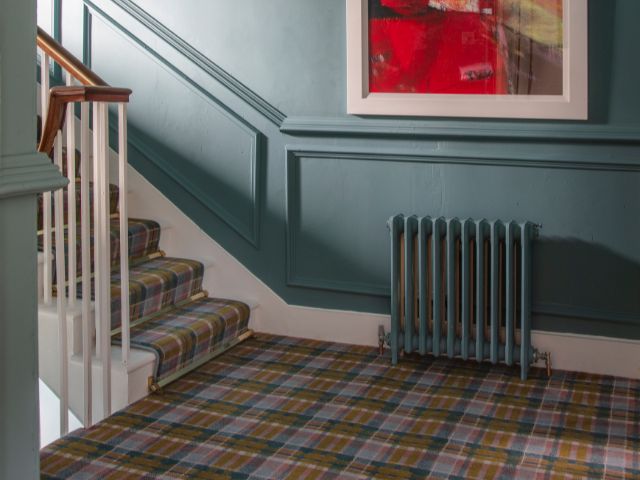
Fringing
Fringing has been making a subtle reappearance in fashion design of late, but the fringe detailing on the AW catwalks was bigger, bolder, and way more fluid.
“No longer just a decorative trim, fringe is taking on a new, oversized, and free-flowing form,” explains Ayisha.
“On the runway, Simone Rocha reimagined fringe with movement and drama—an approach that translates beautifully into interiors.”
While traditional passementerie still has its place on cushions, upholstery, and curtains, Ayisha says the modern interpretation of fringe is far more dynamic, adding texture, softness, and unexpected elegance to a space.
“But forget the old-world, overly ornate versions of the past; gone are the days of heavy, tasselled trims.
“Today’s fringed furniture is sleek, modern, and undeniably stylish, focusing on soft movement, texture, and unexpected elegance,” she adds.
“A fringed ottoman brings playful sophistication, adding depth and dimension without overwhelming a space.”
Lighting is another way to incorporate some fancy fringing.
“Fringe in lighting is both playful and luxurious, bringing softness and movement to an interior,” explains Ayisha.
“House of Hackney-style fringed lampshades evoke vintage glamour, casting an ambient, shimmering glow.
“Meanwhile modern sculptural fringed chandeliers turn fringe into a dynamic, floating form, interacting with light and shadow.
“This can be applied across the board from table lamps, floor lamps to pendants and even sconces – adding movement and visual interest to any interior.”
Oversized fringing isn’t just for furniture either, it can also bring tactile depth to vertical surfaces too. ”Fringed wall tapestries or fabric panels create layers and movement, adding a dramatic but organic element to a room,” Ayisha continues.
“Hanging fringe installations, almost like textile curtains or partitions, bring a sense of lightness and separation, perfect for defining zones in open-plan spaces.
“Much like Rocha used fringe to create deliberate gaps and movement in garments, interiors can embrace free-flowing fringe panels to subtly divide spaces.”
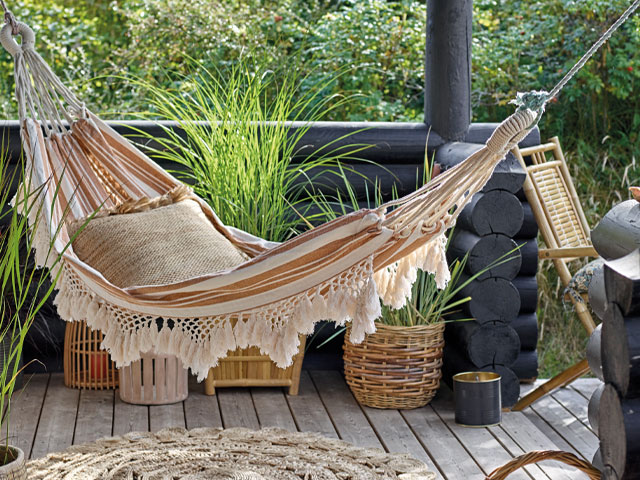
Icy blues and greens
Soft, icy blues and greens have taken over fashion in the form of pastel coats, shimmering fabrics, and ethereal evening wear.
Interiors are embracing these shades for their calming and luxurious appeal.
“Seen on runways from Balenciaga to Fendi, these serene, frosty shades create a calming, sophisticated atmosphere,” explains Debbie Leigh, design manager at ILIV.
“To get the look in your own home try incorporating soft blue velvet cushions, mint green throws, or window dressings in cool tones.
“Glass accessories in pale blues and greens are also great for adding a chic, frosty touch.”
Kunal suggests incorporated these icy shades into a statement wall or millwork.
“A powdery blue wall or a deep icy green lacquered kitchen adds an elegant, serene feel,” he continues.
“My top tip, go floor to ceiling with the cabinetry to really elevate the look.”
Another way to harness these hues, he suggests, is through mid-sheen velvet sofas, silk cushions, or sheer curtains for a dreamy, light-reflective quality.
“Pair with brushed brass, gold, or silver to add a high-end, polished contrast,” he adds.
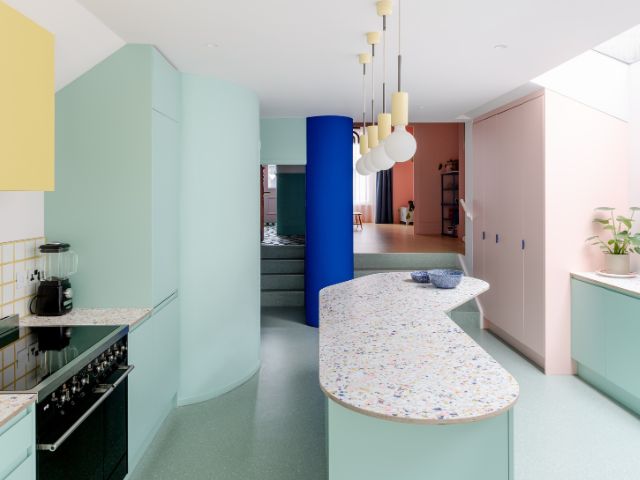
Looking for more interiors inspiration? Take a look at 80s décor is BACK – 15 ways to embrace the trend or Wabi Sabi interiors: 11 ways to get the calming look in your home
READ MORE:




